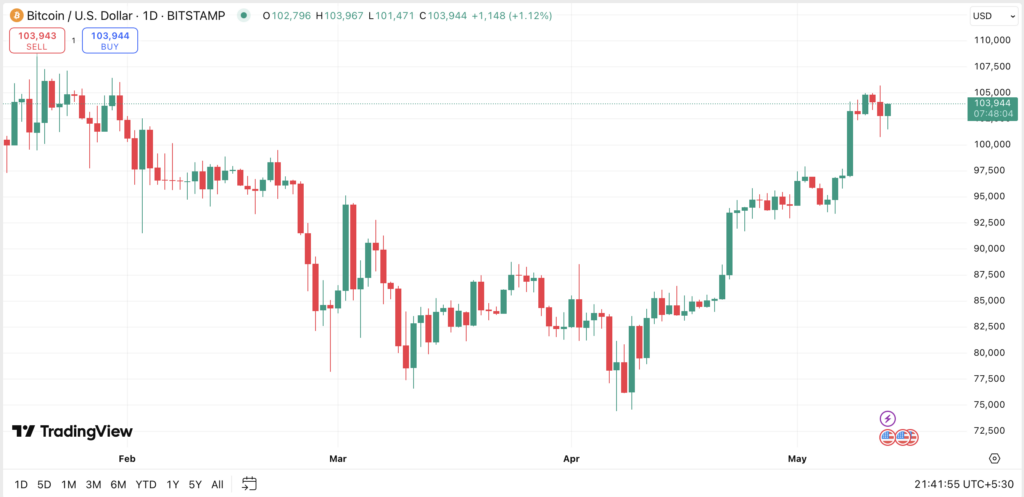Can a 90-day US-China trade truce really reshape global liquidity — and push Bitcoin toward a new all-time high?
Markets exhale as tariff pressures ease
On May 11–12, the United States and China announced a temporary truce in their ongoing trade dispute, a development that brought immediate relief to global markets.
After months of intensifying tariffs and persistent economic uncertainty, both sides agreed to a 90-day pause on new trade restrictions.
The deal, finalized after talks in Geneva, includes a substantial rollback of existing tariffs and a set of targeted commitments aimed at reviving bilateral trade.
Under the terms of the agreement, the U.S. reduced tariffs on $350 billion worth of Chinese imports, lowering rates from 145% to 30%. In response, China cut duties on $120 billion in American goods, reducing rates from 125% to 10%.
A key highlight was China’s agreement to resume purchases of Boeing aircraft. It also committed to importing $50 billion annually in U.S. soybeans and liquefied natural gas, signaling renewed cooperation in critical export categories.
In the technology sector, both countries agreed to ease restrictions on semiconductor exports for the duration of the truce.
Several non-trade measures were also addressed. The U.S. removed a longstanding e-commerce exemption, and China pledged to implement tighter controls on fentanyl precursor chemicals.
Sectors such as agriculture, energy, aerospace, and semiconductors are expected to benefit directly from these easing measures.
Financial markets reacted swiftly. On May 12, the S&P 500 rose 3.26%, reflecting a rebound in risk sentiment. The U.S. dollar index (DXY) slipped 0.2% to 101.6, reducing currency pressure on emerging markets and lifting risk assets across the board.
While these effects are already visible in traditional markets, the next question is how this shift in global trade dynamics and the return of investor risk appetite could influence crypto prices. Let’s find out.
Bitcoin breaks out as risk appetite returns
Bitcoin’s (BTC) response to the trade truce was immediate and sharply directional. On May 11, ahead of the official announcement, BTC was already trading near $100,000, supported by rising optimism surrounding the Geneva discussions.
As confirmation of the tariff cuts emerged on May 12, Bitcoin climbed to reach $105,740, its highest level in over a month. As of this writing, BTC is trading near $104,400, up nearly 2% over the previous 24 hours.

The move aligned with improving sentiment across risk assets and was reinforced by a notable shift in the Crypto Fear and Greed Index, which rose to 70 on May 13 from 59 the previous week.
Although the uptick signals growing optimism, the index remains below the “Extreme Greed” zone, indicating traders are engaged but have not yet reached levels of excessive positioning or overheated momentum.
Bitcoin’s broader rally has been building since early April. After falling to $75,000 during the peak of trade-related market stress, BTC has rebounded in a near V-shaped pattern.
The recovery has been fueled by sustained inflows into spot exchange-traded funds (ETFs), underlining institutional conviction.
Over the past week alone, Bitcoin gained 10%, supported by strong demand from large allocators. Spot Bitcoin ETFs have now logged three consecutive weeks of net inflows, totaling over $5.8 billion, according to data from SoSoValue.
The price surge has also shifted Bitcoin’s standing in global asset rankings. At its current valuation, it has surpassed both silver and Google, making it the sixth-largest tradable asset worldwide.
Ethereum (ETH) has moved in tandem, gaining nearly 44% to trade close to $2,560 as of this writing, marking its strongest performance since December 2020 and reflects the broader improvement in investor confidence across digital assets.
The total crypto market cap has also recovered sharply, now standing at $3.32 trillion, a clear rebound from April’s low of $2.42 trillion when trade tensions dragged down risk assets across the board.
Inflation cools, rate cut odds rise
The broader macroeconomic backdrop is beginning to shift in response to the U.S.–China trade deal, and this recalibration could open new doors for crypto, particularly Bitcoin.
In the weeks leading up to the agreement, both nations had pushed import tariffs above 100%, fueling concerns that rising prices would ripple across the global economy.
These fears cast doubt on traditional inflation indicators, with many investors viewing March’s positive CPI data in the U.S. as out of sync with escalating trade friction.
Now that tariffs are being rolled back, that disconnect may begin to fade. The case for trade-driven inflation is weakening, representing a key signal for monetary policy watchers.
If inflation continues to ease as expected, the Federal Reserve could find more room to cut interest rates, improving the liquidity environment for risk assets like Bitcoin.
The latest CPI data for April confirmed this cooling trend. Headline inflation fell to 2.3% year-on-year, below expectations of 2.4%, while core CPI came in at 2.8%, in line with forecasts.
BREAKING: April CPI inflation FALLS to 2.3%, below expectations of 2.4%.
Core CPI inflation was 2.8%, in-line with expectations of 2.8%.
This marks the 3rd straight monthly decline in headline inflation.
Inflation continues to cool down despite the trade war.
— The Kobeissi Letter (@KobeissiLetter) May 13, 2025
This marks the third consecutive monthly decline in headline inflation and the smallest year-over-year increase since February 2021. Notably, it’s also the first inflation dataset that reflects April’s reciprocal tariffs, making the moderation more meaningful.
Fed Chair Jerome Powell added context last week, saying the “underlying inflation picture is good,” and calling the tariff-driven price effects “short-lived.” The Fed left rates unchanged at its most recent meeting, holding the policy range at 4.25% to 4.5%, and reiterated a data-dependent approach.
From a market structure perspective: if CPI continues to come in soft, and Powell’s tone remains dovish, the case for Bitcoin to move beyond $110,000 strengthens.
Still, there are important caveats. The current trade truce is only set for 90 days. Both sides have flagged tougher negotiations ahead, especially around sensitive technology exports and AI governance. U.S. restrictions on Nvidia and TSMC chips remain in place, and renewed tensions could shake risk appetite.
Geopolitical developments also deserve attention. China’s recent military activity near Taiwan has raised concerns about regional stability.
A flare-up in that situation could prompt investors to seek out traditional safe-haven assets like gold or the U.S. dollar. If the dollar index, currently near 102, rebounds toward 105 or higher, Bitcoin’s relative appeal could diminish.
Experts split on what’s driving the next crypto move
To gauge how the U.S.–China trade truce is being absorbed by the crypto market, crypto.news spoke with multiple industry experts who offered their take on what this 90-day pause really means.
Charles Wayn, co-founder of web3 growth platform Galxe, views the current environment as more than a temporary bounce. He believes the truce has neutralized a major macro headwind, allowing crypto to enter a more constructive cycle with broader engagement.
“The US/China trade tariff hiatus signals a shift toward improved macro sentiment that will float all boats, especially crypto. It’s a meaningful step that suggests easing geopolitical tensions, and digital asset markets are responding accordingly.”
Wayn adds that the momentum is expanding beyond Bitcoin:
“With BTC approaching $105,000, we already see speculation that this could push Bitcoin to a new all-time high, with some suggesting $150,000 may be a possibility in the near future. Over the weekend, we also saw a huge rally in the altcoin sector, with ETH surging more than 30% in a much-needed recovery.”
Not everyone shares the same confidence. Kai Wawrzinek, co-founder of Impossible Cloud Network, mentions unresolved infrastructure risks that sit beneath the surface of the trade deal. He points to continuing ambiguity around chip access and cloud dependencies as critical friction points that macro relief alone cannot fix.
“A temporary trade deal between the US and China is not enough to bring the clarity and certainty needed by the global cloud industry, which is highly reliant on Chinese hardware like semiconductors and GPU chips to operate.”
Wawrzinek notes that despite improved sentiment, strategic decisions across the cloud industry remain frozen.
“While some concessions were made to the tech sector in April, there continues to be huge uncertainty here for providers, many of whom, including Microsoft and Amazon, have halted some significant spending on data centers for cloud computing in the midst of this trade war.”
He argues that these limitations open a path for decentralized infrastructure to gain relevance.
“Decentralized networks resist almost all of the risks associated with centralized providers, including outages and hacks caused by single points of failure, along with much lower costs. And perhaps most importantly, decentralized networks resist political and corporate wrangling.”
On-chain data also supports the view that crypto markets are beginning to respond to the macro thaw. PlanB, a widely followed crypto analyst, sees strong parallels between the current momentum and past bull cycles.
“Bitcoin RSI is at 69. I expect at least four months with RSI 80+, just like in previous bull markets, 2021, 2017, and 2013. RSI 80+ is associated with monthly returns of over 40%. Four months of 40%+ return bring BTC from $104,000 to $400,000.”
Adding to that thesis, blockchain analytics firm Santiment has observed a clear behavioral split among wallet segments. Over the past 30 days, large holders with 10 to 10,000 BTC have accumulated over 83,000 BTC, while wallets holding under 0.1 BTC have collectively sold nearly 400 BTC.
“The aggressive accumulation from these large wallets could indicate confidence that Bitcoin may soon test its $110,000 all-time high again,” Santiment reported, though it also cautioned that smaller holders appear to be taking profits at current levels.
From an on-chain perspective, the market appears to be re-engaging. There is no sense of euphoria, but there is clear attentiveness.
Still, early signals alone do not guarantee sustained follow-through. Market cycles often begin by shaking out weak hands before any trend is confirmed. Trade carefully and never invest more than you can afford to lose.




